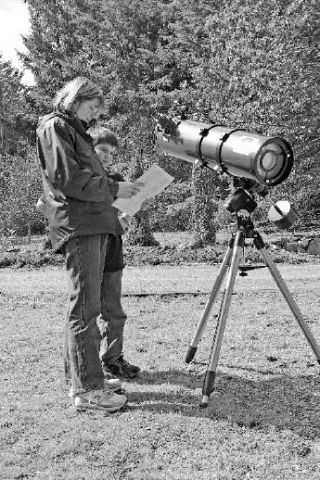Growing up in Chicago was serious business. About the only people who had time to lay on their backs watching the night sky were the winos on Madison Street. I could identify the Big and Little Dippers, but that was the extent of my astronomical education.
So I turned to DAN PULLEN of the Island County Astronomical Society. It cheered me up to hear him say, “Anybody who has even a passing interest in astronomy, we can teach them. Even a layperson like you!” No disrespect intended.
Pullen said club members range in age from 9 to 80 and include accountants, students, plumbers, teachers, moms and dads.
He got his first taste of astronomy in 1991 when he and his wife heard a news report that a comet was about to hit Jupiter. “We ran right out and bought a small telescope and sure enough, we saw it hit! All you need is a good quality telescope on a steady mount.”
“We don’t recommend any telescope bought out of a department store. If it advertises how much power it has, do not buy it.” he said. “Telescopes can cost from $400 to $40,000. Before you buy one, come to our club, ask questions, borrow our club telescopes to practice on. We have three different types of scopes currently.”
He added that he has a 10-inch manual telescope, his 9-year-old grandson has a 4 1⁄2-inch basic manual telescope and his wife Janet has an 8-inch reflector on a motor driven mount.
He said they see satellites, including the International Space Station, all the time, as well as galaxies, star clusters, planets, meteors, double stars and the moons of Saturn and Jupiter.
Pullen would like to see the club grow. “We have 30 paying members and end up with 12 at our meetings which are held the third Monday of every month at 6:30 p.m. downstairs in the First United Methodist Church building regardless of the weather.”
Yearly dues are $20 for adults, $15 for the second family member and $10 for students. With membership comes a subscription to “Reflector” magazine and the use of club telescopes at star parties and for at-home practice.
Right around the corner is the Star Party on April 26 to celebrate Holland Happening. “We want people to stop by our booth during the day and then join us at dark at Fort Nugent Park.
“Some special viewing events like the Moon and Mars parties are held at City Beach Park in Oak Harbor,” Pullen continued. “All of these events are open to the public and no telescope is required.”
If you are curious about astronomy or want to meet local amateur astronomers, these events are a great starting point. Inclement weather or poor visibility may cancel such events. When you enter the park, use your parking lights only.
Call Pullen at 679-7664 or see their cool webpage with some great night sky photos at http://groups.msn.com/Washington
ICAS.
Let’s take a
drive to Langley
On Wednesday, April 23, Whidbey General Hospital is holding a Healthy Living Fair from 1 to 3 p.m. at the Brookhaven Housing Complex in Langley. You may be screened for physical therapy, hearing, speech and balance; get a replacement tip for your cane or a quick tune-up on your walker and learn about how massage and acupuncture can help manage pain. Bring your bag of medicines and have them checked for compatibility. Ask someone how to create living wills, advanced directives and those difficult end-of-life decisions. There’s something for the person who snores a lot or those who can’t seem to quit smoking. Learn how Lifeline can enhance independent living.
Call Michele Renninger, Life Center Manager, at 678-7656, ext. 2136.
That really
chaps my hide
I have been troubled by the sight of horses standing in soaking rain with no trees or wind barrier for protection. If a horse stays wet, he has less chance of staying warm, and a wet horse that hasn’t received routine vaccinations (tetanus, West Nile virus, influenza and equine encephalitis) is headed for trouble.
A horse can survive on a good quality grass pasture, salt and ample water. A meal of Eastern Washington grass hay provides needed amino acids, carbohydrates, protein, vitamins and minerals. A 1,000-pound horse needs 16,000 to 17,000 calories a day.
Average annual costs to feed a horse runs from $1,000 to $1,200, a farrier costs from $200 to $400 and vet services run from $200 to $500. A national survey shows it costs horse owners from $2,000 to $2,500 to keep just one horse.
With these numbers, I can see why some people might put a horse in a pasture and forget about it. Sadly, Animal Control can only act when a horse shows signs of being underweight and underfed. Freezing weather or scorching heat, there are no requirements to provide a horse with a blanket or shelter. When a fashion model is so thin her hip bones jut out, we call that anorexia. When the hip bones on a horse stick out, I call that neglect.
Although I will be away, my column will continue in the coming weeks with features prepared in advance of my absence. I plan to check on my messages, so you may still call me at 675-6611 or send me your story ideas at life
onwhidbey@yahoo.com. My new left knee and I expect to be back in the office on May 12, courtesy of Dr. Richard Williamson of Anacortes and Island Paratransit.



